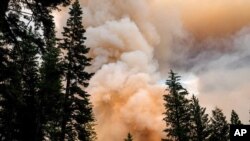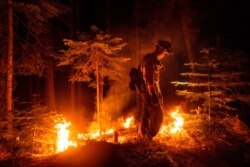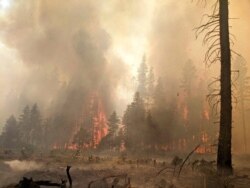Cooler weather on Tuesday helped calm two gigantic wildfires in the U.S. West, but property losses mounted in a tiny California community savaged by flames last weekend and in a remote area of Oregon that are both bracing for more hot, dry conditions that have been making the blazes so explosive.
Teams reviewing damage from the massive Dixie Fire in the mountains of Northern California have so far tallied 36 structures destroyed and seven damaged in the remote community of Indian Falls, said Nick Truax, an incident commander for the fire. It's unclear if that figure included homes or smaller buildings.
The assessment was about half done, Truax said in an online briefing Monday night, and the work depends on fire activity.
The Dixie Fire has scorched more than 842 square kilometers (325 square miles), an area bigger than New York City, and it was partially contained Tuesday. More than 10,000 homes were threatened in the region about 282 kilometers (175 miles) northeast of San Francisco.
A historic drought and recent heat waves tied to climate change have made wildfires harder to fight in the American West. Scientists say climate change has made the region much warmer and drier in the past 30 years and will continue to make weather more extreme and wildfires more frequent and destructive.
An inversion layer, which is a cap of relatively warmer air over cooler air, trapped smoke over much of the fire Monday, and the shade helped lower temperatures and keep humidity up, incident meteorologist Julia Ruthford said.
Similar smoke conditions were expected through Tuesday. Monsoon moisture was streaming in over the region, but only light showers were likely near the fire. A return to hotter, drier weather was expected later in the week.
The Dixie Fire, burning mostly on federal land, is among dozens of large blazes in the U.S.
With so many fires, officials have to prioritize federal resources, said Nickie Johnny, incident commander for the Dixie's east section, crediting help from local governments and California's firefighting agency.
"I just wanted to thank them for that because we are strapped federally with resources all over the nation," she said.
Authorities also were hopeful that cool temperatures, increased humidity and isolated showers will help them make more progress against the nation's largest wildfire, the Bootleg Fire in southern Oregon. Crews have it more than halfway contained after it scorched 1,657 square kilometers (640 square miles) of remote land.
"The mild weather will have a short-term calming effect on the fire behavior. But due to the extremely dry conditions and fuels, as the week progresses and temperatures rise, aggressive fire behavior is likely to quickly rebound," a situation report said Tuesday.
The lightning-sparked fire has destroyed 161 homes, 247 outbuildings and 342 vehicles in Klamath and Lake counties, the report said, cautioning that the numbers could increase as firefighters work through the inner area of the fire.
Elsewhere, high heat was expected to return to the northern Rocky Mountains, where thick smoke from many wildfires drove pollution readings to unhealthy levels.
Unhealthy air was recorded around most of Montana's larger cities — Billings, Butte, Bozeman and Missoula — and in portions of northern Wyoming and eastern Idaho, according data from U.S. government air monitoring stations.
In California, the 275-square-kilometer (106-square-mile) Tamarack Fire south of Lake Tahoe was chewing through timber and chaparral but was more than halfway contained. Evacuation orders for about 2,000 residents on both sides of the California-Nevada line have been lifted. At least 23 buildings have burned.













